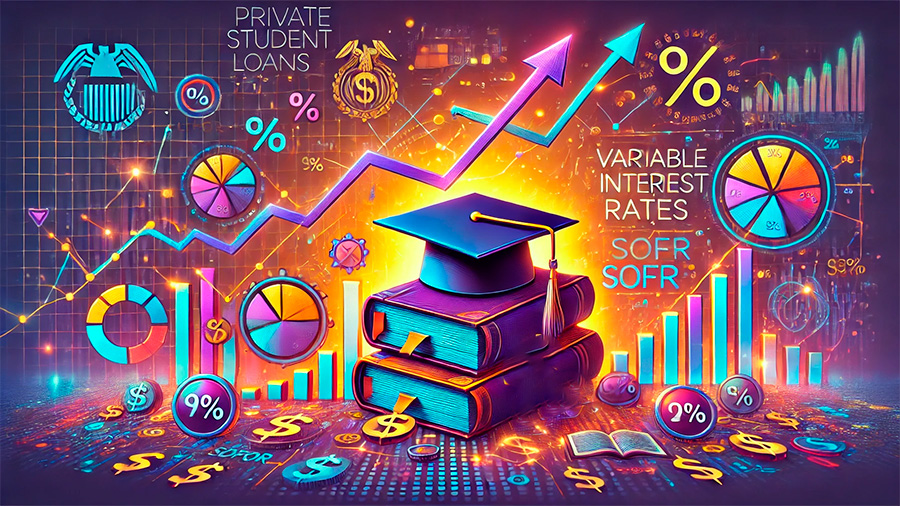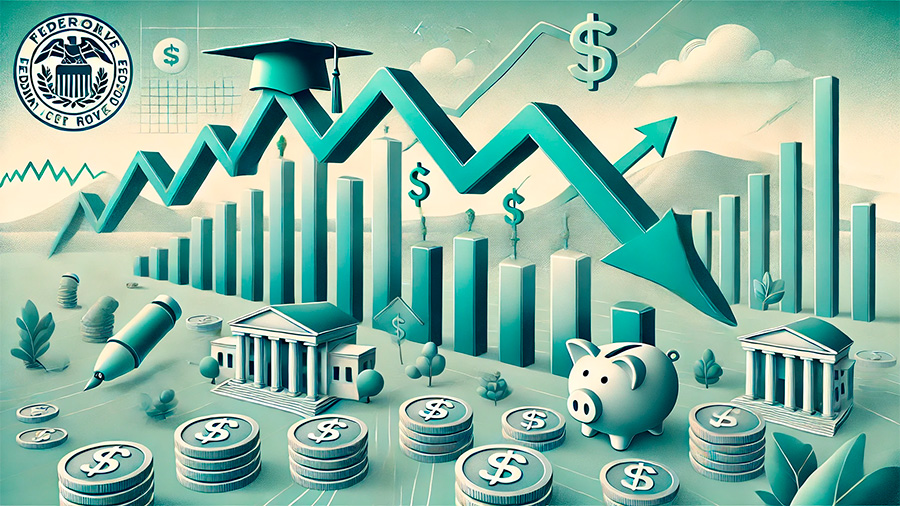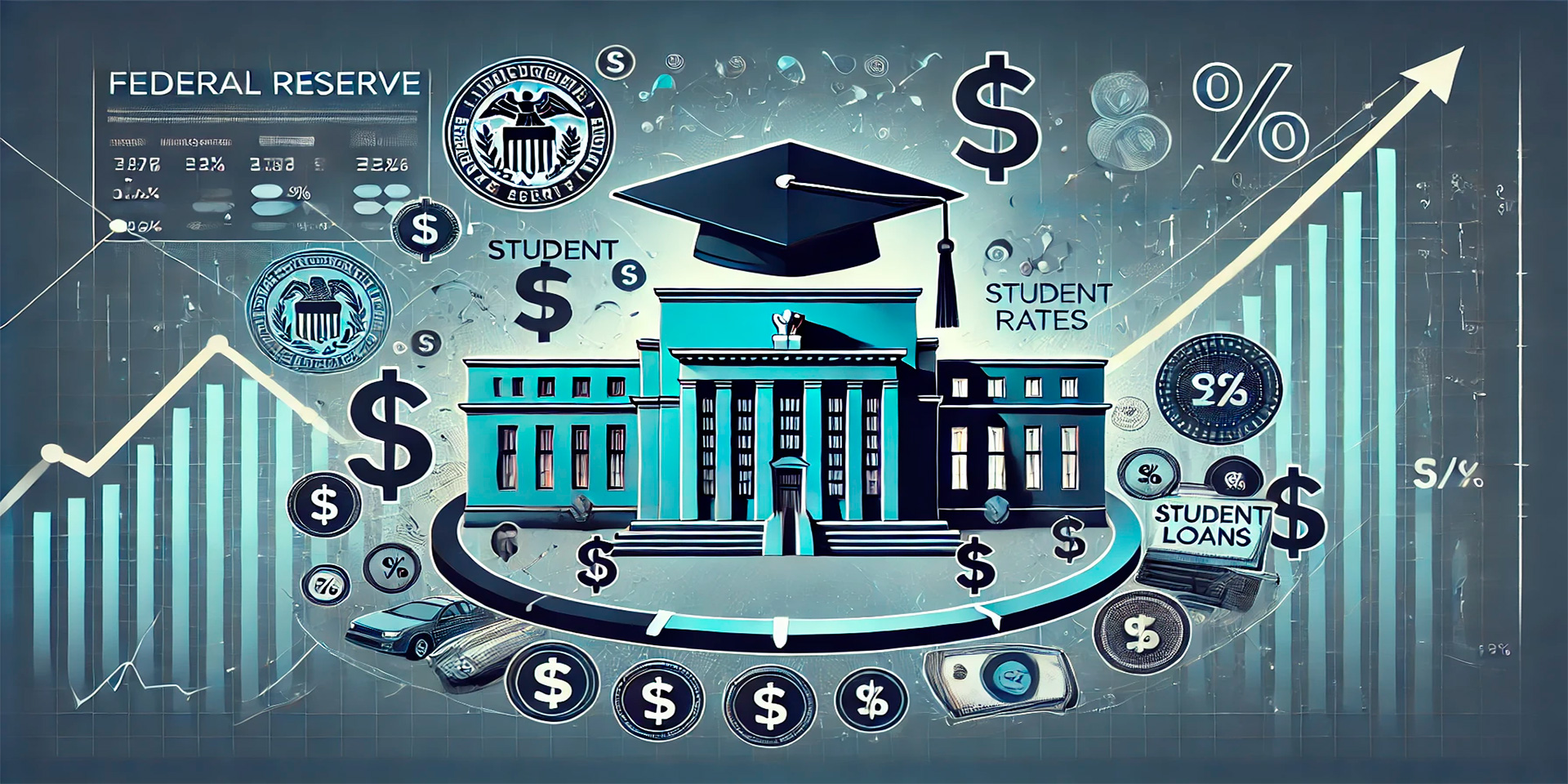The Federal Reserve (commonly referred to as the Fed) plays a crucial role in determining interest rates across the economy, including those that affect student loans. The Fed sets the federal funds rate, which is the interest rate at which banks lend to each other overnight. Although the federal funds rate doesn’t directly set student loan rates, it influences the broader financial market, including the cost of borrowing for consumers. When the Fed raises or lowers rates, it impacts everything from credit cards to mortgages—and importantly, student loans. Understanding how these rate changes affect your education loans can help you better manage your repayment strategy.
Why the Fed’s Rate Matters to Student Loan Borrowers
The Fed’s interest rate decisions ripple through the financial system, affecting both new and existing loans. When the Fed raises rates, borrowing becomes more expensive as lenders pass on the increased costs to consumers. On the other hand, when the Fed cuts rates, borrowing costs generally decrease, which can make student loans more affordable. The impact on student loans depends on whether you have federal or private loans, as these two types of loans are affected differently by Fed rate changes.

How Fed Rate Changes Impact Federal Student Loans
Federal student loans are issued by the U.S. Department of Education, and their interest rates are fixed, meaning they don’t change over the life of the loan. These rates are set annually based on the 10-year Treasury note auction, not directly by the Fed. However, the Fed’s actions still indirectly influence these rates. When the Fed raises interest rates, Treasury yields tend to increase, leading to higher rates for new federal student loans issued in the following year.
Fixed Rates for Federal Student Loans
No impact on existing loans: If you already have a federal student loan with a fixed rate, Fed rate changes won’t affect your current interest rate. Your payments will remain the same, regardless of what the Fed does.
Impact on new loans: For new borrowers or those taking out additional federal loans, the Fed’s influence on Treasury rates can lead to higher interest rates in future loan cycles.
While existing federal loans are shielded from immediate changes in interest rates, students taking out new loans in high-rate environments will face higher borrowing costs.
How Fed Rate Changes Impact Private Student Loans
Private student loans, unlike federal loans, often have variable interest rates that can fluctuate with market conditions. These loans are typically tied to a benchmark interest rate such as the London Interbank Offered Rate (LIBOR), the Secured Overnight Financing Rate (SOFR), or the prime rate, all of which are influenced by the Fed’s interest rate decisions. When the Fed raises rates, variable-rate private student loans can become more expensive, as lenders adjust their rates upward in response.
Variable vs. Fixed Rates for Private Loans
Variable-rate loans: If you have a private student loan with a variable rate, the Fed’s actions can cause your interest rate to rise or fall over time. For example, during a period of rate hikes, your monthly payments may increase as your interest rate adjusts upward.
Fixed-rate loans: Like federal loans, private fixed-rate student loans are not directly impacted by Fed rate changes once they are issued. However, new fixed-rate private loans may come with higher rates in response to a rising-rate environment.
For borrowers with variable-rate private student loans, the Fed’s rate decisions can have a more immediate and noticeable impact on monthly payments.
Rate Hikes: What Happens When the Fed Raises Rates?
When the Fed raises interest rates, it’s typically in response to strong economic growth or rising inflation. A rate hike increases the cost of borrowing across the board, and student loans are no exception. For federal student loans, a rate hike will affect the interest rates on new loans, making them more expensive for future borrowers. Private student loan borrowers with variable-rate loans will see their interest rates—and monthly payments—increase in response to the Fed’s decision.
Impact on New Borrowers and Refinancers
New federal loans: Students borrowing federal loans after a rate hike can expect to pay higher interest rates than borrowers who took out loans when rates were lower.
Private loan refinancers: Borrowers looking to refinance their student loans may face higher rates after a Fed rate hike, especially if they opt for variable-rate refinancing.
If the Fed continues to raise rates, the cost of borrowing for education will likely continue to rise, making it more expensive for students and graduates to finance or refinance their education.

Rate Cuts: How Fed Cuts Can Lower Borrowing Costs
When the Fed lowers rates, typically in response to a slowing economy or to stimulate growth, it can reduce the cost of borrowing. This means that new federal student loans may come with lower interest rates if issued during or after a period of rate cuts. For private student loans with variable rates, monthly payments may decrease as interest rates are adjusted downward in response to the Fed’s actions.
How to Benefit from Rate Cuts
Lower rates on new loans: If you’re planning to take out a federal student loan during a period of lower rates, you’ll likely benefit from more affordable borrowing costs.
Refinancing opportunities: Private loan borrowers with variable rates may see their payments decrease after a rate cut, and it may be a good time to refinance if you’re looking for more favorable loan terms.
During periods of rate cuts, borrowers have opportunities to lower their interest costs and potentially save money over the life of their loans.
Refinancing Student Loans During Rate Changes
Refinancing student loans can be a powerful tool for borrowers looking to take advantage of changing interest rates. When you refinance, you replace your existing loan with a new one, ideally at a lower interest rate. This is especially beneficial in a falling-rate environment, where you can secure lower payments. However, refinancing federal loans into private loans comes with risks, such as losing access to federal loan benefits like income-driven repayment plans and loan forgiveness options.
When Is the Right Time to Refinance?
During rate cuts: If the Fed lowers interest rates, it might be a good time to refinance private loans to lock in lower rates, particularly if you have variable-rate loans.
After rate hikes: Even after a rate hike, refinancing may still make sense if you can qualify for better terms based on your improved credit score or financial situation.
Before refinancing, carefully weigh the benefits of lower interest rates against the loss of federal loan protections if you’re considering moving from federal to private loans.
Managing Student Loan Payments During Fed Rate Changes
As the Fed adjusts interest rates, your student loan repayment strategy may need to change as well. For those with federal loans, you may not feel the effects of rate changes immediately, but it’s important to be mindful of how future borrowing costs may increase. Private loan borrowers, particularly those with variable rates, should stay alert to changes in their loan payments and consider refinancing options if rates rise or fall significantly.
Tips for Managing Your Loans
Monitor Fed rate announcements: Keep an eye on Fed decisions to anticipate changes in borrowing costs, especially if you have private student loans.
Consider fixed rates: If you’re concerned about rising rates, locking in a fixed rate through refinancing can provide peace of mind and predictable payments.
Use income-driven repayment plans: Federal loan borrowers can explore income-driven repayment plans to manage payments if rates or other economic conditions make repayment more difficult.
By staying informed about the Fed’s actions and understanding how they impact student loans, you can make smarter decisions about borrowing and repayment, ultimately reducing your overall loan costs.
Changes in the Fed’s interest rate policies can have a significant impact on both federal and private student loan borrowers. By understanding how rate hikes or cuts affect your loans, you can adjust your strategy to take advantage of lower rates or protect yourself against rising costs. Whether you’re a current borrower or planning to take out student loans, staying informed about the Fed’s actions is crucial for managing your education debt effectively.

